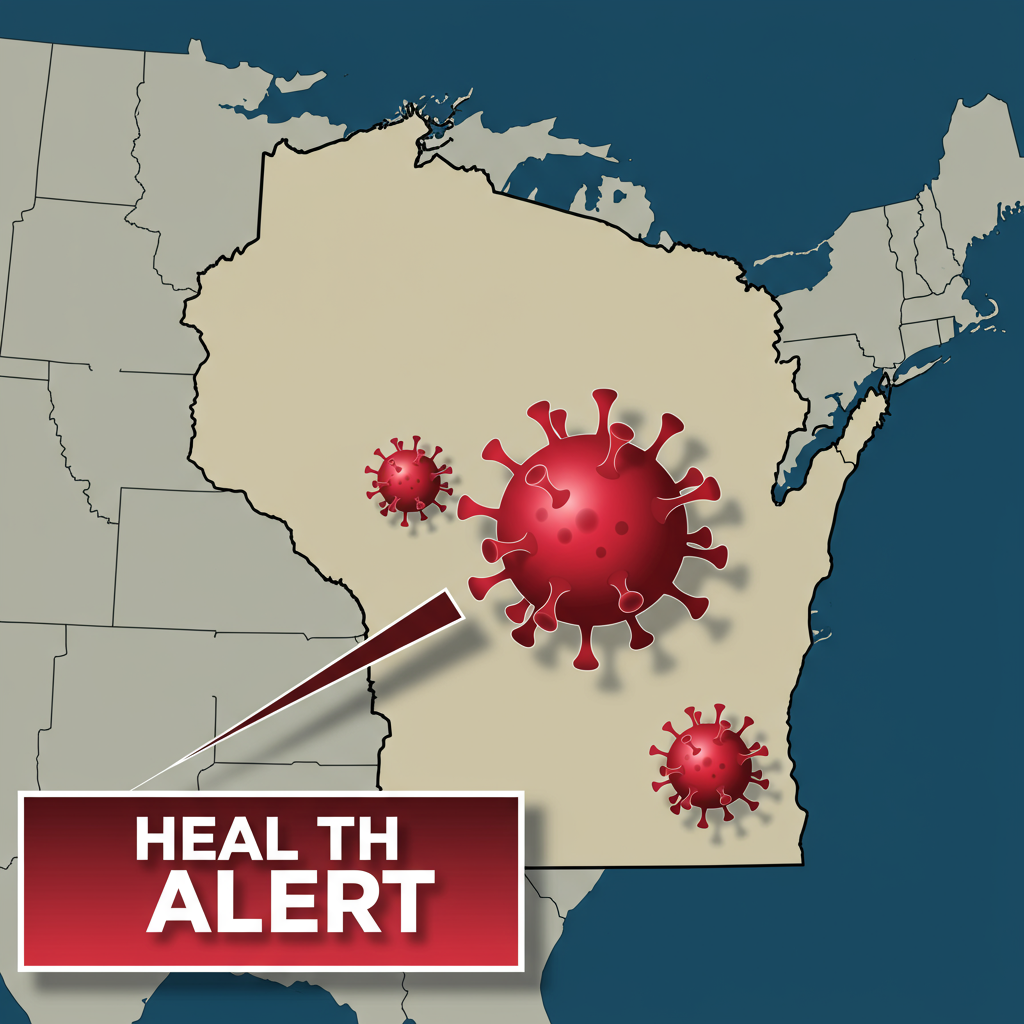Wisconsin health authorities have issued an urgent public health update following the confirmation of nine measles cases, marking the first instances of the highly contagious virus in the state this year. All confirmed cases are concentrated in Oconto County and have been directly linked to out-of-state travel. While officials indicate a low risk of public exposure for these initial cases, this development underscores Wisconsin’s heightened vulnerability amidst a national resurgence of measles. Public health experts are emphasizing the critical importance of vaccination to curb the spread of this preventable disease.
Wisconsin’s First Measles Cases of 2025 Emerge
The Wisconsin Department of Health Services (DHS) recently confirmed nine measles cases within Oconto County. These cases represent the first verified occurrences of measles in the Badger State for 2025. Health officials have meticulously traced the source of exposure for all nine individuals to a common origin during out-of-state travel, suggesting an external introduction of the virus into Wisconsin.
The confirmation process involved thorough public health measures. One of the nine cases was definitively verified through comprehensive laboratory testing at the Wisconsin State Laboratory of Hygiene. The remaining eight cases were identified and confirmed based on their documented exposure history to the common source, coupled with the manifestation of typical measles symptoms. Despite these confirmed cases, the DHS reports that no widespread public points of exposure have been identified, leading to a current assessment of low risk for the broader community. However, vigilance remains paramount given measles’ highly infectious nature.
Understanding Measles: A Highly Contagious Threat
Measles is an exceptionally contagious viral illness, known for its rapid transmission. The virus spreads through airborne droplets when an infected person coughs or sneezes, and can linger in the air for up to two hours after the person has left the area. Alarming statistics show that up to 90 percent of unvaccinated individuals exposed to someone with measles can contract the disease.
Symptoms typically appear between 10 to 21 days following exposure. Initial signs often resemble a severe cold, including a high fever, persistent cough, runny nose, and red, watery eyes. These are usually followed, within two to three days, by the characteristic measles rash. This red, blotchy rash, often with raised bumps, usually begins at the hairline and on the face, then spreads downwards to the neck, torso, arms, and legs. While many may consider measles a benign childhood illness, it can lead to severe complications, including pneumonia, encephalitis (brain swelling), deafness, and even death. Nationally, roughly one in ten measles cases has resulted in hospitalization, and three deaths have been reported across the U.S. so far this year.
Why Wisconsin Faces Unique Vulnerability
The emergence of these Wisconsin measles cases comes as the United States navigates its most significant measles resurgence in over three decades. With more than 1,300 cases reported nationally by late July, the country is witnessing levels not seen since 1992. Measles, which was declared eliminated in the U.S. in 2000, has resurfaced primarily due to declining vaccination rates among young children. This national trend has significantly increased the risk of outbreaks.
Wisconsin, unfortunately, holds one of the lowest childhood measles, mumps, and rubella (MMR) vaccination rates nationally, contributing to its current vulnerability. As of 2023, only 81 percent of 2-year-olds in Wisconsin had received the MMR vaccine, a notable decrease from 88 percent in 2013. The statewide kindergartner MMR vaccination rate stands just under 85 percent, well below the 95-98 percent threshold public health experts identify as necessary for achieving herd immunity and effectively preventing outbreaks. Certain rural areas within the state present even greater concerns, with counties like Clark and Vernon reporting vaccination rates as low as 50 percent and 44 percent respectively for young children. Over 90 percent of nationwide cases have occurred in unvaccinated individuals or those with unknown vaccination status, underscoring the vaccine’s critical role.
Wisconsin’s Proactive Public Health Preparedness
In anticipation of potential measles outbreaks, Wisconsin’s local health departments have been intensifying their preparedness strategies. Following the confirmation of the Oconto County cases, these efforts are being amplified. Health departments are actively conducting simulated outbreak exercises, developing robust staffing plans, and meticulously analyzing local vaccination trends. Many, including Milwaukee’s health department, have engaged vital community partners such as schools, hospitals, and first responders in these drills to ensure a seamless and coordinated response during an actual event.
A standard protocol for any confirmed measles case involves rapidly identifying the individual’s infectious period and initiating comprehensive contact tracing. Public health officials work tirelessly to reach all potentially exposed persons. Individuals who cannot demonstrate immunity after exposure, particularly those who are unvaccinated, are advised to quarantine for 21 days, adhering to CDC guidelines. Lessons learned from the COVID-19 pandemic, especially regarding contact tracing capacity, are also shaping current measles preparedness efforts. Departments are assessing their limits and planning for backup personnel, while regional collaborations, like public health mutual aid agreements between neighboring counties, are being formalized to lend support during disease outbreaks.
Ensuring Vaccine Accessibility and Overcoming Barriers
A crucial aspect of measles prevention is ensuring wide access to the MMR vaccine. While local health departments receive some vaccine doses from the state specifically for uninsured or underinsured children and adults, the supply for adults has often struggled to meet demand. To mitigate this potential shortfall during an outbreak, some proactive departments, such as Milwaukee’s, have privately purchased hundreds of doses. Others, like Public Health Madison & Dane County, are exploring similar actions to ensure they can serve residents without other vaccination options.
Significant disparities in vaccination rates persist across Wisconsin, highlighting challenges faced by different communities. While urban centers like Milwaukee and Madison counties generally show higher 2-year-old vaccination rates exceeding the state average, rural areas often grapple with unique barriers. These include limited healthcare access, substantial transportation challenges, diverse cultural beliefs concerning medicine, and the pervasive spread of misinformation. In response, public health nurses in counties like Clark, home to a significant Amish and Mennonite population, conduct annual visits to over 60 schools to collect immunization data and encourage vaccination. They also host numerous immunization clinics in homes and schoolhouses throughout the year, demonstrating a tailored approach to community engagement.
Your Role: Protecting Yourself and Your Community
Given the recent developments and measles’ high transmissibility, ensuring up-to-date MMR vaccination is the most effective protective measure. The state health department confirms that two doses of the MMR vaccine are approximately 97 percent effective in preventing measles.
For children, the recommended schedule includes the first dose between 12 and 15 months of age, and the second dose between ages four and six. Individuals planning international travel or visiting parts of the U.S. experiencing measles outbreaks should consult their healthcare provider. For high-risk travel scenarios, children aged 6 to 12 months can receive an early dose of the vaccine. Furthermore, Wisconsin’s updated guidelines now permit the second booster dose to be administered as soon as one month after the first, offering increased flexibility for accelerated protection. Anyone born before 1957 is generally considered immune and typically does not require vaccination. However, all other adults without laboratory evidence of immunity are advised to receive at least one dose of a measles-containing vaccine. If you develop measles-like symptoms, it is crucial to contact your healthcare provider before visiting a clinic or hospital, to prevent potential further transmission to other patients and staff. The MMR vaccine is rigorously tested and proven safe, with its potential risks vastly outweighed by the severe health consequences of contracting measles.
Checking Your Immunization Records in Wisconsin
For Wisconsin residents concerned about their vaccination status, accessing immunization records is straightforward. The primary tool for this is the Wisconsin Immunization Registry (WIR), an online database designed to track vaccine records for both children and adults across the state. The WIR provides immediate access to a resident’s vaccination history, detailing which vaccines were received, where and when they were administered, and when future immunizations are due.
While the WIR offers individual access to personal records, the public does not have access to specific patient data, as the DHS strictly adheres to laws protecting patient confidentiality. You can access the registry via instructions provided on the DHS website, with the platform available in English, Spanish, and Hmong. To retrieve your records through WIR, you will typically need to provide your first and last name, date of birth, and either a Social Security number, Medicaid ID number, or a health care member ID number. After entering the required information and clicking “Search,” the WIR will display your vaccine records and any upcoming or due vaccinations, with an option to print the records for your convenience. If a search yields “No match found,” it’s advised to contact your healthcare provider directly to request your vaccine records, as not all providers consistently utilize WIR. Additionally, the WIR does not track out-of-state vaccinations, so individuals born outside Wisconsin will need to contact their state’s respective immunization program for those records. For further assistance, residents can visit the DHS’ immunizations webpage or contact their help desk.
Frequently Asked Questions
What are the typical symptoms of measles and how is it spread?
Measles symptoms usually begin with a high fever, runny nose, cough, and red, watery eyes. After a few days, a characteristic red, blotchy rash appears, starting on the face and spreading downwards to the rest of the body. Measles is extremely contagious, spreading through airborne droplets when an infected person coughs or sneezes. The virus can remain in the air for up to two hours, making it easy to contract if you are unvaccinated and exposed to an infected individual.
How can Wisconsin residents check their measles vaccination records?
Wisconsin residents can check their immunization records, including measles vaccination status, through the Wisconsin Immunization Registry (WIR). This online database, managed by the Wisconsin Department of Health Services (DHS), allows individuals to access their vaccine history. You’ll need to provide your name, date of birth, and a Social Security number, Medicaid ID, or health care member ID. If your records aren’t found in WIR, contact your healthcare provider directly.
Given the recent cases, what proactive steps should I take to protect my family from measles?
The most crucial proactive step is ensuring everyone in your family is up-to-date on their Measles, Mumps, and Rubella (MMR) vaccine. Two doses of the MMR vaccine offer about 97% protection against measles. For children, follow the recommended schedule (1st dose at 12-15 months, 2nd at 4-6 years). If traveling internationally or to outbreak areas, consult your doctor about early vaccination options. Also, be aware of symptoms and contact your doctor before visiting a clinic if you suspect measles to prevent further spread.
Stay Informed and Protected
The confirmation of nine measles cases in Oconto County serves as a powerful reminder of the importance of public health vigilance. While the immediate risk to the general public is assessed as low, the ongoing national measles surge and Wisconsin’s specific vulnerabilities highlight the need for proactive measures. The MMR vaccine remains the most effective tool in preventing measles and protecting our communities. By understanding the symptoms, ensuring up-to-date vaccinations, and knowing how to access your immunization records, Wisconsin residents can play a vital role in curbing the spread of this preventable disease and safeguarding public health.


